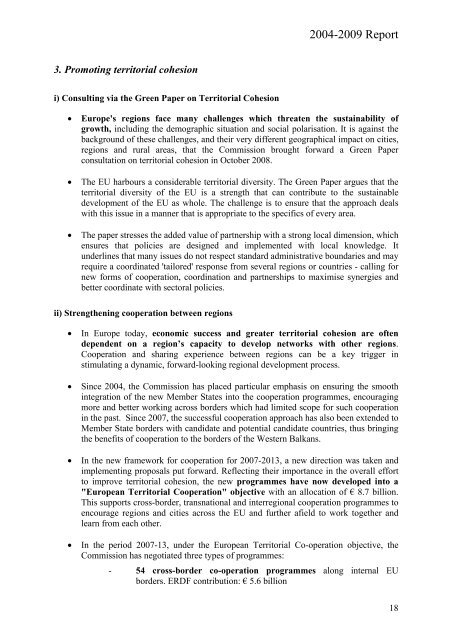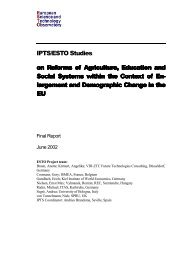Achievements of Europe's regional policy 2004-2009 - Et2050.eu
Achievements of Europe's regional policy 2004-2009 - Et2050.eu
Achievements of Europe's regional policy 2004-2009 - Et2050.eu
You also want an ePaper? Increase the reach of your titles
YUMPU automatically turns print PDFs into web optimized ePapers that Google loves.
<strong>2004</strong>-<strong>2009</strong> Report<br />
3. Promoting territorial cohesion<br />
i) Consulting via the Green Paper on Territorial Cohesion<br />
• <strong>Europe's</strong> regions face many challenges which threaten the sustainability <strong>of</strong><br />
growth, including the demographic situation and social polarisation. It is against the<br />
background <strong>of</strong> these challenges, and their very different geographical impact on cities,<br />
regions and rural areas, that the Commission brought forward a Green Paper<br />
consultation on territorial cohesion in October 2008.<br />
• The EU harbours a considerable territorial diversity. The Green Paper argues that the<br />
territorial diversity <strong>of</strong> the EU is a strength that can contribute to the sustainable<br />
development <strong>of</strong> the EU as whole. The challenge is to ensure that the approach deals<br />
with this issue in a manner that is appropriate to the specifics <strong>of</strong> every area.<br />
• The paper stresses the added value <strong>of</strong> partnership with a strong local dimension, which<br />
ensures that policies are designed and implemented with local knowledge. It<br />
underlines that many issues do not respect standard administrative boundaries and may<br />
require a coordinated 'tailored' response from several regions or countries - calling for<br />
new forms <strong>of</strong> cooperation, coordination and partnerships to maximise synergies and<br />
better coordinate with sectoral policies.<br />
ii) Strengthening cooperation between regions<br />
• In Europe today, economic success and greater territorial cohesion are <strong>of</strong>ten<br />
dependent on a region’s capacity to develop networks with other regions.<br />
Cooperation and sharing experience between regions can be a key trigger in<br />
stimulating a dynamic, forward-looking <strong>regional</strong> development process.<br />
• Since <strong>2004</strong>, the Commission has placed particular emphasis on ensuring the smooth<br />
integration <strong>of</strong> the new Member States into the cooperation programmes, encouraging<br />
more and better working across borders which had limited scope for such cooperation<br />
in the past. Since 2007, the successful cooperation approach has also been extended to<br />
Member State borders with candidate and potential candidate countries, thus bringing<br />
the benefits <strong>of</strong> cooperation to the borders <strong>of</strong> the Western Balkans.<br />
• In the new framework for cooperation for 2007-2013, a new direction was taken and<br />
implementing proposals put forward. Reflecting their importance in the overall effort<br />
to improve territorial cohesion, the new programmes have now developed into a<br />
"European Territorial Cooperation" objective with an allocation <strong>of</strong> € 8.7 billion.<br />
This supports cross-border, transnational and inter<strong>regional</strong> cooperation programmes to<br />
encourage regions and cities across the EU and further afield to work together and<br />
learn from each other.<br />
• In the period 2007-13, under the European Territorial Co-operation objective, the<br />
Commission has negotiated three types <strong>of</strong> programmes:<br />
- 54 cross-border co-operation programmes along internal EU<br />
borders. ERDF contribution: € 5.6 billion<br />
18







